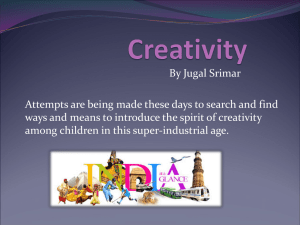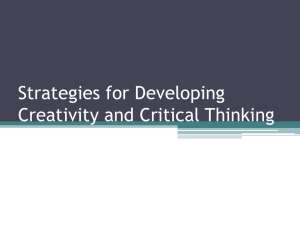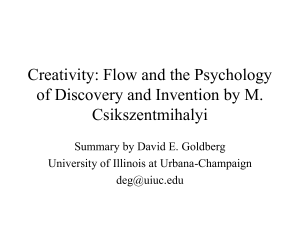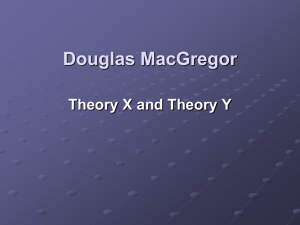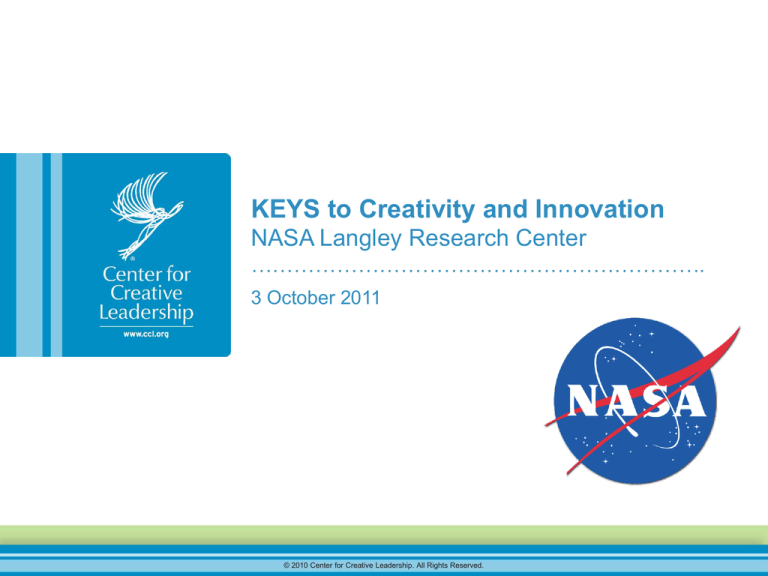
KEYS to Creativity and Innovation
NASA Langley Research Center
……………………………………………………….
3 October 2011
© 2010 Center for Creative Leadership. All Rights Reserved.
LaRC Mission Strategy
© 2010 Center for Creative Leadership. All Rights Reserved.
KEYS to Creativity and Innovation…
• A tool to help leaders see a clear picture of the work climate
within a work group or organization.
• That climate, also known as the work environment, greatly
influences an employee’s ability to be creative.
• The value of KEYS lies in its capacity to accurately identify
the conditions necessary for innovation to occur.
© 2010 Center for Creative Leadership. All Rights Reserved.
KEYS to Creativity
and Innovation…
FedView Survey
Describes the work environment
for creativity and innovation:
• Management Practices
• Organizational Motivation
• Resources and Workload
Pressure
Outcomes – Creativity and
Productivity
Addresses three Human Capital
Assessment Accountability
Framework systems (HCAAF):
• Leadership/Knowledge
Management
• Results-Oriented Performance
• Talent Management
Answers the question: “what are
the current levels of stimulants
and obstacles to creativity and
innovation that exist in my work
environment?”
Answers the question: “do I want
to join, stay and help the agency
meet its mission?”
© 2010 Center for Creative Leadership. All Rights Reserved.
KEYS to Creativity and Innovation…
Factors/Scales
• Freedom
• Challenge
• Managerial Encouragement
• Work Group Supports
• Organizational Encouragement
• Lack of Organizational Impediments
• Sufficient Resources
• Realistic Workload Pressure
Outcomes – Creativity and Productivity
© 2010 Center for Creative Leadership. All Rights Reserved.
Impact of the Work Environment
resources
Work Environment
management
practices
Innovation
Individual/Team
Creativity
expertise
creativity
skills
intrinsic
motivation
© 2010 Center for Creative Leadership. All Rights Reserved.
Creativity
Implementation
organizational
motivation
KEYS to Creativity and Innovation
“Most important factors…
A) Supporting
B) Inhibiting
C) To Improve
the climate for creativity and innovation.”
© 2010 Center for Creative Leadership. All Rights Reserved.
Sample Graph
© 2010 Center for Creative Leadership. All Rights Reserved.
KEYS Normative Group
•
The KEYS norm group consists of 186 groups made up of 22,000 individuals with the
data representing a variety of functions and departments in hundreds of different
organizations.
•
These organizations represent many industries including: automotive, high tech,
government, biotechnology, electronics, chemicals, pharmaceuticals, health care
products, and consumer products. Various functions include: traditional research and
development, engineering, marketing, sales, manufacturing, and administration.
•
Scoring is standardized for ease in making comparison; 10 points represents 1
Standard Deviation. 68% of the scores in the normative group fall within the shaded
blue area; 16% in the Very High and 16% in the Very Low (white).
© 2010 Center for Creative Leadership. All Rights Reserved.
Government
This graph compares dimension ratings (as standard scores) to a specific normative group (detail provided in the heading). The
mid-range line marks the average of the CCL normative group (a mean of 50 and a standard deviation of 10). In this graph, ratings
range from 20 to 80. Because the ratings are close to normally distributed, less than 1% of ratings fall outside the 20-80 range and
two-thirds of all groups will fall between 40 and 60.
80
70
Very High
60
High
Mid-range
50
Low
40
30
Very Low
20
©2010 Center for Creative Leadership. All Rights Reserved.
KEYS Data - Langley Research Center
Organization N=1,747
(50% Response Rate)
© 2010 Center for Creative Leadership. All Rights Reserved.
Key Findings?
What hypothesis do you have about the perceptions to
creativity and innovation in the work environment at NASA
Langley Research Center?
•
•
•
•
•
Big Picture
Executive Team
Civil Servants – Contractors
Term - Perm
Level
© 2010 Center for Creative Leadership. All Rights Reserved.
“The climate for creativity and
innovation is both strong and
positive. The primary
elements for mission success
at NASA LaRC from an
innovation perspective are
among the highest we've
experienced”
John R. Ryan ~ CEO
Center for Creative Leadership
© 2010 Center for Creative Leadership. All Rights Reserved.
Key Findings (Overall)
• The climate for creativity and innovation at NASA LaRC is viewed as
positive compared to CCL’s robust normative group
• The work environment supports the management practices,
organizational motivation and resources needed for innovation to
occur
• There is low agreement about what sustains, inhibits, and
suggestions for improving creativity and innovation
• Across the organization, there is a perception that failure is not
acceptable even when the effort is good
• Some people in the organization are very concerned about protecting
their territory
• Some respondents feel that the budget for their specific project(s) is
NOT adequate;
– “insufficient money” is the largest factor inhibiting C&I and “more money”
is the suggestion most cited for improving C&I
– Budget was the only item rated “VERY LOW”
© 2010 Center for Creative Leadership. All Rights Reserved.
© 2010 Center for Creative Leadership. All Rights Reserved.
© 2010 Center for Creative Leadership. All Rights Reserved.
© 2010 Center for Creative Leadership. All Rights Reserved.
© 2010 Center for Creative Leadership. All Rights Reserved.
© 2010 Center for Creative Leadership. All Rights Reserved.
© 2010 Center for Creative Leadership. All Rights Reserved.
© 2010 Center for Creative Leadership. All Rights Reserved.
© 2010 Center for Creative Leadership. All Rights Reserved.
© 2010 Center for Creative Leadership. All Rights Reserved.
Key Findings (Director Level)
• Director Level staff see the climate as significantly more
positive in almost all respects.
• Director Level staff indicated that they do not have
enough time for the work that must be done and feel a
greater sense of time pressure than other staff
• Insufficient money was #1 factor cited as an inhibitor to
creativity and innovation (42%)
• A lack of trust within the team was cited (23%)
• Risk avoidance was a top four inhibitor (19%)
© 2010 Center for Creative Leadership. All Rights Reserved.
KEYS Data - Langley Research Center
Directors N=26
© 2010 Center for Creative Leadership. All Rights Reserved.
© 2010 Center for Creative Leadership. All Rights Reserved.
© 2010 Center for Creative Leadership. All Rights Reserved.
Key Findings (Contractors – Civil Servants)
As compared to Civil Servants, the data are similar although
Contractors report:
- that there are very few distractions from project work
- there is a good blend of skills in the work group
- they see the workload more favorably
- good team relations and blend of skills
- they are personally very creative in their work
- the budget for projects as more favorable
- a lack of severe workload pressure
© 2010 Center for Creative Leadership. All Rights Reserved.
Key Findings (Contractors – Civil Servants)
Contractors also report:
- that there is a lack of encouragement to take risks
- failure is not acceptable even if the effort was good
- they have less freedom to decide what projects to do
- viewing the organization as more strictly controlled by
upper management
- that their job tasks are less challenging when
compared to civil servants
© 2010 Center for Creative Leadership. All Rights Reserved.
KEYS Data - Langley Research Center
NASA (CS) N= 1,009
Contractors N= 707
© 2010 Center for Creative Leadership. All Rights Reserved.
© 2010 Center for Creative Leadership. All Rights Reserved.
© 2010 Center for Creative Leadership. All Rights Reserved.
© 2010 Center for Creative Leadership. All Rights Reserved.
Key Findings (Perm – Term Employees)
• Perm employees see the climate for creativity and
innovation as slightly more positive than Term
• They see less organizational urgency for successful
completion of the work
• Permanent employees report “VERY HIGH” scores for:
– Managerial interactions with direct reports
– Support of work and ideas by their manager
– Fair/supportive evaluation
– Rewards/recognition for creative work
© 2010 Center for Creative Leadership. All Rights Reserved.
KEYS Data - Langley Research Center
PERM N=853
TERM N=124
© 2010 Center for Creative Leadership. All Rights Reserved.
© 2010 Center for Creative Leadership. All Rights Reserved.
© 2010 Center for Creative Leadership. All Rights Reserved.
Key Findings (Level)
• The higher you are in the organization, the more positive
you see the climate
• Non-supervisory Employees (Clerical, Secretarial and
Support Staff, Technicians, Fabricators) rate “Realistic
Workload Pressure” VERY HIGH (positive)
• Directors are less willing to help each other (mid-range)
than at all other levels
• Directors, Deputy Directors and Branch Heads rate
failure as more acceptable than Team Leaders and Nonsupervisory staff
• Budget was rated VERY LOW by Branch Heads
© 2010 Center for Creative Leadership. All Rights Reserved.
KEYS Data - Langley Research Center
LEVEL
Director N=26
Dept. Director N=42
Branch Head N=115
Team Leaders N=452
Non-Supervisory N=1,112
© 2010 Center for Creative Leadership. All Rights Reserved.
KEYS Insights
• Vision: Where do we want to go?
• KEYS Data: Where are we now?
• Action Plan: How do we get there?
© 2010 Center for Creative Leadership. All Rights Reserved.
What Drives Innovation?
“Leaders will get the most innovative results
from their teams if they view their role as
providing their teams with the environment
they need to be effective, and then giving
them the respect, responsibility, and
freedom to do good work” PPS-SNAPSHOT:August 2011
© 2010 Center for Creative Leadership. All Rights Reserved.
DAC
• Direction: Agreement on what the collective
is trying to achieve together
• Alignment: Effective coordination and
integration of work so that it fits together
• Commitment: Willingness to make the
success of the collective (not just individual
success) a personal priority
© 2010 Center for Creative Leadership. All Rights Reserved.
Leader’s Role in
Generating DAC
Have
Produce
•
•
Equip people
with skills to
participate
Improve your
own ability to
participate
Impact
•
•
Create more
leadership
processes
Create better
leadership
processes
© 2010 Center for Creative Leadership. All Rights Reserved.
•
Pay attention to
whether
leadership is
happening
Implications - Reflection
What questions do these data create?
• Does KEYS data support the results of the FEVS and other
information you know?
• How to sustain a positive climate for creativity and innovation?
• What might get in the way; how to prevent that from happening?
• What role can leadership play at NASA LaRC to continue improving
the work environment?
• What leadership issues need to be addressed at the executive team
level (Directors)?
• When is it acceptable to put in a good work effort and fail?
• What are the implications of staff protecting their territory?
• How can “challenging work” and “freedom” be improved in the
contractor employee population?
© 2010 Center for Creative Leadership. All Rights Reserved.


